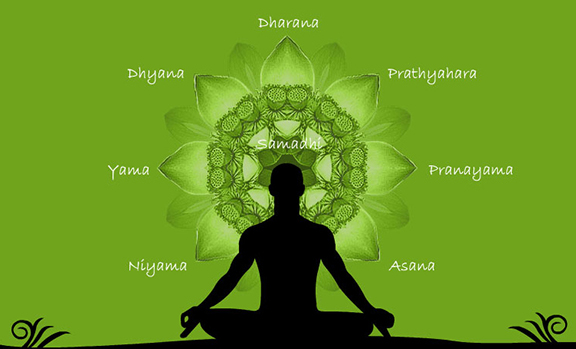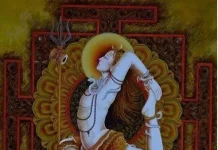Yoga, Ayurveda and related Vedic disciplines have more connections than usually acknowledged, particularly in the West. We cannot understand one of these systems without the others. All are part of an integrated stream of higher knowledge as Vedic knowledge or Vedic sciences. The Yoga Sutras arises out of the Vedic tradition of ancient India, with Yoga as one of the six schools of Vedic philosophy. Yoga is coupled along with Samkhya philosophy, but is widely followed in Vedanta.
By Dr. David Frawley
Yoga is a broader topic than Yoga Sutras, reflected in various schools of Yoga in the Vedas, Upanishads, Puranas, Tantras and the dharmic schools of philosophy in India, Vedic and non-Vedic. Yoga is rooted in Vedic mantras starting with OM. The many branches of Yoga include Jnana Yoga, Bhakti Yoga and Karma Yoga, as well as Raja Yoga and Hatha Yoga, Prana Yoga and Mantras Yoga.
The Yoga Sutras are the main text of Yoga Darshana, but does not represent its beginning. Yoga Darshana is rooted in an older Hiranyagarbha tradition, mentioned in the Mahabharata, which connects it with the Vedas. Hiranyagarbha is regarded as the founder of Yoga Darshana, with Patanjali, the compiler of its teachings at a later period.
The Yoga Sutras remains the most important text of traditional Yoga, though there are many other texts. As a brief Sutra work, consisting of two hundred axiomatic statements, it relies upon commentaries and other branches of Vedic thought for its full explication.
The Yoga Sutras is a practical text and does not go into detail into philosophy. Yoga Sutras deals primarily with sadhana or spiritual practice aimed at developing a state of Samadhi, control of the mind or Self-realization (also defined as realization of the Purusha). It discusses states of mind, knowledge, cognition and awareness on various levels as part of this process.
Ayurveda and Yoga
Ayurveda is one of the four Upavedas or secondary Vedic texts. Its specific concern is health and well-being for body and mind. Ayurveda is a complete system of medicine in terms of diagnosis and treatment, internal and external medicine, dietetics, herbology, psychology, right living, longevity and rejuvenation. Ayurveda rests upon Samkhya and Vedantic thought and mentions Yoga in various contexts. In the original scheme of Vedic knowledge, Yoga is primarily a Sadhana school aimed at Self-realization beyond the body and mind. Ayurveda is the Chikitsa school aimed at healing of body and mind. There is considerable overlap between Yoga and Ayurveda. When classical Yoga speaks of the health benefits of Yoga practice, these are usually placed in the greater therapeutic scheme of Ayurveda. Ayurveda formed the dominant medical discourse of ancient India at the time of the Yoga schools.
Hatha Yoga mentions Ayurveda in terms of doshas (biological humors), prana, agni (digestive fire) and dhatus (tissues) relative to the physical side of the practice. Yogis use Ayurvedic herbs and many Yoga centers in India have promoted Ayurveda.
Charaka Samhita, the most central of classical Ayurvedic texts, mentions Yoga, Samkhya and Vedanta. Ayurveda predates Patanjali and does not mention him in its older texts, though it does refer to Yoga. Charaka mentions Yoga mainly as Raja Yoga, or Yoga as connected to psychological therapies.
Charaka prescribes Yoga for Moksha or liberation from all suffering, and emphasizes Yogic values and practices like yamas and niyamas for health of both body and mind, and for rejuvenation, Ayurveda’s highest and ultimate therapy. Yoga practices form part of Ayurveda’s behavioral medicine and Yoga is part of an Ayurvedic life-style.
Classical Ayurveda has three levels of treatment:
The first is the “Yukti Vyapashraya” or rational therapy that consists of reduction of the three doshas of Vata, Pitta and Kapha. This is the main scope of its physical treatment and consists of life-style practices, diet, herbs, and clinical methods like Pancha Karma to reduce the doshas as the main causative factors behind the disease process.
The second is “Sattvavajaya” therapy for the increase of sattva guna. On this level, Ayurveda employs the practices of Yoga, starting with the yamas and niyamas. For Ayurveda, sattvavajaya is the main psychological therapy. Ayurveda views rajas and tamas as the doshas or factors of disease on the level of the mind, and the increase of sattva guna as the basis of wellbeing at a psychological level. Yoga Sutras defines Yoga as control of the mind and the elimination of mental suffering. It explains the factors of psychological suffering through the kleshas, and promotes sattva guna as a prime factor to accomplish this.
The third level of Ayurvedic treatment is the “Divya chikitsa” or spiritual therapy. This consists of rituals, mantras, gemstones, pilgrimage, devotion, and other practices in order to remove karmic afflictions, notably Vedic astrology. Yoga is an integral part the main therapeutic approaches of Ayurveda.
Ayurveda comprises a complete Yogic system of medicine. It has a yogic view of the human body and mind, understanding of the disease process, and a full range of treatment measures and lifestyle disciplines for health and wellbeing. Ayurveda takes the principles of Vedic, Yoga and Samkhya thought and extends them into the realm of healing for body and mind. It has an extensive literature and history describing different diseases, diagnosis, prognosis and treatment.
Yoga Therapy Today
During the British colonial era in India, Ayurvedic schools were closed down. This suppression of Ayurveda in the colonial era meant that when Yoga first came to the West, it did so without its older Ayurvedic background or connections.
People began to apply Yoga for health benefits, but did not know Ayurveda. They defined Yoga for health in terms of modern medicine or other medical systems like naturopathy. Even in India, Yoga as a therapy was dominated by doctors trained in modern medicine but not trained in Ayurveda.
Today there is a new spread of Yoga therapy or Yoga Chikitsa worldwide. Some of this rests upon Ayurveda, but other parts rest upon modern medical systems. Many teachers in this Yoga for health approach have little knowledge of Ayurveda and like to view Yoga therapy and Ayurveda as two different but related systems, not as rooted in each other.
If we examine the Yoga Sutras we find that the term chikitsa is not mentioned in the text. The term Yoga chikitsa is rare in traditional Yoga literature. The four sections of the Yoga Sutras are defined in terms of Samadhi, Sadhana, Vibhuti and Kaivalya, or purely spiritual concerns of Self-realization. There are no specific Yoga Chikitsa texts from the ancient period, though the health benefits of Yoga practices are mentioned in the existing Yoga literature.
Chiktsa is a common term in Ayurvedic texts, with Charaka and Sushruta Samhitas having a Chikitsa sthana or Chikitsa/treatment section, describing Ayurvedic therapies. This rests upon a section relating to disease theory and diagnosis, called Nidana, and to another describing anatomy, physiology and the workings of body and mind called Sharirika sthana.
In other words, Chikitsa or treatment is primarily a concern of Ayurveda as part of a full medical system in terms of theory, diagnosis and treatment. There is no independent tradition of Yoga therapy or any traditional Yoga system of medicine or approach to disease apart from Ayurveda. To talk of Yoga therapy apart from Ayurveda or as different from Ayurvedic therapy is a new approach, not that of the older traditions.
A true Yoga Chikitsa or Yoga therapy should rest upon a yogic nidana or yogic diagnosis and theory of disease, and a full set of treatment measures that address diet, herbs, massage, detoxification and rejuvenation. This is provided by Ayurveda. We need not create a new yogic system of medicine but need only restore the original connections between Yoga and Ayurveda, with Ayurveda as the medical or healing branch of Yoga and Vedic knowledge.
Mind and Prana
Yoga Sutras defines Yoga as control of the mind or chitta. This occurs through reducing the qualities of rajas and tamas and increasing that of sattva. This reflects the psychological approach of Ayurveda as noted.
Yet the vrittis or movements of the mind rest upon the movements of Prana. Chitta spanda and Prana spanda, vibratory rates of mind and prana, go together. Hatha Yoga emphasizes control of Prana for controlling the mind.
Control of Prana implies control of the physical prana, Vata dosha that is the root of the other two doshas of Pitta and Kapha. Control of the mind benefits from balancing the doshas, which are both physical and psychological factors. This further connects Yoga and Ayurveda.
Yoga and Ayurveda work extensively with Prana and the five Vayus of prana, apana, samana, vyana and udana, which are the five subtypes of Vata dosha in Ayurveda, whose imbalances are reflected in the disease process. Vata, Pitta and Kapha are physical manifestations of Prana.
Besides the doshas as disease factors are master forms of the doshas that promote positive health, immunity and longevity. These are Ojas (higher form of Kapha), Tejas (higher form of Pitta) and Prana (higher form of Vata). Ojas is also commonly mentioned in Yoga literature.
Hatha Yoga is concerned with balancing pranic energies much like Ayurveda, including balancing the ida and pingala nadis that reflect the solar and lunar energies of Pitta (fire or sun) and Kapha (water or moon).
Yoga also works with the Agni concept of Ayurveda. This is not just the jatharagni or digestive fire but extends to the pranagni or pranic fire, which aids in the purification of the mind, and the Yogagni or fire of Yoga overall. To understand the energetics of Yoga practice extending to Kundalini, chakras and Tantric Yoga, it helps to understand their Ayurvedic implications of these terms.
Asana Therapy
Ayurveda recommends asanas as a physical therapy for musculoskeletal disorders in a primary sense with secondary benefits extending to all the organs and systems of the body. Ayurveda prescribes exercise according to the individual doshic or mind-body type. These have their relevance in the health prescriptions of Yoga asanas.
Pranayama and Pranic Healing
Classical Yoga defines pranayama in Ayurvedic terms of sun and moon, doshas, agni, heating and cooling effects. Ayurveda uses pranayama to balance the doshas and promote positive health. Ayurveda considers Pranayama as the most important health practice that we can do. Bringing in more Prana helps correct afflictions of the body and mind and developing our own healing power.
Meditation and Mantra
Ayurveda recognizes the importance of mantra and meditation in healing the mind and recommends them as part of a healthy life-style. Mantra removes negative samskaras from the mind and meditation heals the mental field. It is the main Ayurvedic tool for healing the mind.
Shadkarmas
Hatha Yoga employs the Shadkarmas or six purification practices. These are similar to the five purification practices of Pancha Karma in Ayurveda. Yet in Ayurveda these practices are prescribed in a more systematic manner and relative to an individual diagnosis of the individual that can make them safer and more effective.
Dietary Factors
Yoga promotes a sattvic diet. Ayurveda also promotes a sattvic diet for calming the mind but adjusts it relative to individual doshic concerns.
Disease Theory
According to Ayurveda there are two main causes of disease. The first is called “Prajnaparadha” or wrong judgment. This equates to ignorance or avidya among the five kleshas of Yogic thought. Its removal relates to Yoga practices of dharana, dhyana and samadhi.
Second, common cause of all diseases is the wrong use of the senses. This relates to raga-dvesha or attraction and repulsion among the five kleshas and implies therapies based upon asana, pranayama and pratyahara.
On the basis of these two factors, Ayurveda brings in the physical causes of the disease process relative to the doshas, external pathogens, the movement of time and the aging process.
Conclusion
Yoga Sutras provides an excellent system of psychological treatment, particularly if integrated into Ayurveda as complete natural healing system.
As Yoga teachers focus more on the Yoga Sutras, they should remember how it fits into Ayurveda as the Vedic system of healing.
Yoga teachers should strive to gain a basic knowledge of Ayurveda relative to health and disease for body and mind. This will make them better teachers and help them expand the scope of their practice. Yoga therapists should study Ayurveda deeply, integrating Yoga therapy with an Ayurvedic therapeutic approach, diagnosis and prognosis.
Ayurveda and Yoga together form a complete system of wellbeing for body, mind and consciousness relevant for all people, all cultures and all time. It can be adjusted to our modern life circumstances with many benefits for everyone.
Yoga groups today, particularly in India, are bringing in more Ayurveda and restoring the natural connections between these two important Vedic disciplines. The Yoga-Ayurveda connection is once more spreading globally and will likely become the dominant trend in Yoga therapy in years to come.
An integral Yoga-Ayurveda is one of the most important ancient and modern trends in Yoga that deserves a greater study and application.
This article first appeared in www.vedanet.com and it belongs to them.












